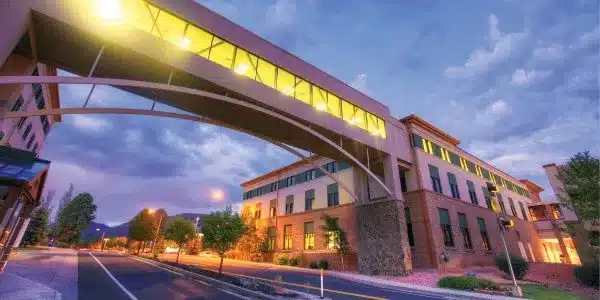Expanding outpatient services in central Flagstaff
We have listened to the community and we understand there’s a strong desire to keep some services in central Flagstaff, even as we explore locations for a new hospital.
Therefore, we are planning to keep a number of services very close to the current hospital location, even after we move the Level I Trauma Center Hospital to a new site in the future.
We have begun to locate some services at our NAH Health Clinic – Central Flagstaff, 1895 N. Jasper Dr. This includes our vascular and cardiothoracic surgery clinic. The next phases for the Central Flagstaff Clinic in 2024 will include our expanded cardiology services, expanded primary care offices and a new urgent care clinic.
Additionally, in 2024 we will begin remodeling and expanding an outpatient surgery center at 1485 N. Turquoise Drive. The property is formerly known as the Summit Center, and when it reopens in mid-2026, it will house an array of services:
- This will be the new home for NAH’s 27,000 square-foot outpatient surgery center with six operating rooms, post-operative recovery space and two pain procedure rooms.
- The remodeled and expanded surgery center will also include a 4,700 square-foot hyperbaric wound clinic to house two hyperbaric wound chambers, six exam rooms and will include room to expand for future needs.
- A 14,800 square-foot orthopedic and neurosurgery clinic will also be in this location, including x-ray facilities, exam rooms and procedure rooms.
- A 5,200 square-foot outpatient EntireCare Sports & Rehab Medicine physical therapy clinic.
Exploring locations for a new hospital
Northern Arizona Healthcare is committed to providing the health care services the region needs for the next 50 years. As part of that plan, we have identified that we cannot grow in place at the current Flagstaff Medical Center (FMC) location. We’ve studied the options and we cannot bring the necessary space-per-room required by hospital building codes while also accommodating all of the services the region needs.
Therefore, we are exploring locations for a new hospital to serve the region with modern medical facilities and technology. FMC has served the community remarkably well for more than 50 years, but after innumerable expansions, remodels and interior adjustments, the aging facility cannot continue to serve the region and meet modern medical regulations and standards. Building a new hospital the region needs will require a property that is not bisected by a public street, with no opportunities to expand outward due to fully developed land around it.
Why a new hospital?
It’s time for a hospital that is designed for just one patient per room (no roommates) with space for visitors in every room. It’s time for operating rooms that can accommodate all of the modern equipment needed to keep patients safe and healthy while in our care.
It’s time for an Emergency Department that can process and prioritize patients, each with their own unique set of needs , so those who need to be admitted to the hospital can be, and so those who need less care can be treated and discharged without waiting hours to be seen.
It’s time for Intensive Care Unit (ICU) rooms that have natural light, room for medical personnel and equipment, and restrooms, rather than rooms that are not large enough to accommodate necessary equipment at the same time as doctors, nurses and other providers.
It’s time for patient rooms that can be easily converted from a more standard hospital room to an ICU whenever needed. It’s time for a hospital with more adult beds so we have room to serve more people during medical surges and times of high need, such as winter respiratory virus season.
We’re committed to providing all of that, and more, in a new facility. We are looking for a property that can serve this need. Unlike our previous design concept, we will not be seeking a space that can accommodate retail and commercial development on-site.
